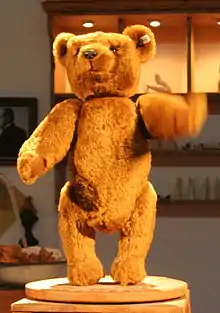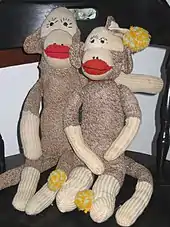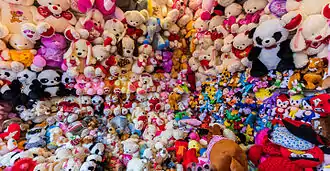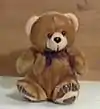Stuffed toy
A stuffed toy is a toy doll with an outer fabric sewn from a textile and stuffed with flexible material. They are known by many names, such as plushies, stuffed animals, plush toys, or stuffies. In Britain and Australia, they may be called soft toys or cuddly toys. The toy originated from Germany in the late 19th century and gained popularity following the creation of the teddy bear in 1903.

Stuffed toys are made in many different forms, but most resemble real animals (sometimes with exaggerated proportions or features), legendary creatures, cartoon characters, or inanimate objects. They can be commercially or home-produced from numerous materials, most commonly pile textiles like plush for the outer material and synthetic fiber for the stuffing. Stuffed toys are popular for a range of ages and uses and have been marked by fads in popular culture that sometimes affected collectors and the value of the toys. Most stuffed animals are child-friendly, but some are not.
History

The first stuffed toy was a felt elephant originally sold as a pincushion, created by the German Steiff company in 1880.[1] Steiff used newly developed technology for manufacturing upholstery to make its stuffed toys.[2] In 1892, the Ithaca Kitty became one of the first mass-produced stuffed animal toys in the United States.[3]
The toy industry significantly expanded in the early 20th century. In 1903, Richard Steiff designed a soft stuffed bear that differed from earlier traditional rag dolls because it was made of plush furlike fabric.[2] At the same time in the US, Morris Michtom created the first teddy bear after being inspired by a drawing of President "Teddy" Roosevelt with a bear cub.[4] In 1903, the character Peter Rabbit from English author Beatrix Potter was the first stuffed toy to be patented.[5] The popularity of stuffed toys grew, with numerous manufacturers forming in Germany, the United Kingdom,[1] and the United States.[2] Many people also handmade their own stuffed toys. For instance, sock monkeys originated when parents turned old socks into toys during the Great Depression.[6]
Description

Stuffed toys are distinguished from other toys primarily by their softness, flexibility, and resemblance to animals or fictional characters. Stuffed toys most commonly take the form of animals, especially bears (in the case of teddy bears), mammalian pets such as cats and dogs, and highly recognizable animals such as zebras, tigers, pandas, lizards, and elephants. Many fictional animal-like characters from movies, TV shows, books, or other entertainment forms often appear in stuffed toy versions, as do both real and fictional humans if the individual or character is famous enough.
Stuffed toys come in an array of different sizes, with the smallest being thumb-sized and the largest being larger than a house.[7][8] However, the largest somewhat commonly produced stuffed animals are not much bigger than a person. The majority of stuffed animals are between a few inches tall and a foot tall or more. They also come in a wide variety of colours and fur textures.
Stuffed toys are commonly sold in stores worldwide. Vendors are often abundant at tourist attractions, airports, carnivals, fairs, downtown parks, and general public meeting places of almost any nature, especially if there are children present.
Use
Children as well as adults can form connections with their stuffed toys, often sleeping or cuddling with them for comfort. They can be sentimental objects that reduce anxiety around separation, self-esteem, and fear of the night.[9] About a third of British adults report sleeping with soft toys, and almost half have kept their childhood toys.[10]
Production
Stuffed toys are made from a range of materials. The earliest were created from felt, velvet, or mohair and stuffed with straw, horsehair, or sawdust.[1][11] Following World War II, manufacturers began to adopt more synthetic materials into production,[1] and in 1954, the first teddy bear made from easily washable materials was produced.[7] Modern stuffed toys are commonly constructed of outer fabrics such as plain cloth, pile textiles like plush or terrycloth, or sometimes socks. Common stuffing materials include synthetic fiber, batting, cotton, straw, wood wool, plastic pellets, and beans. Some modern toys incorporate technology to move and interact with the user.[12]
Manufacturers sell two main types of stuffed toys: licensed, which are toys of characters or other licensed properties, or basic, which take the shape of ordinary animals or other non-licensed subjects.[12]
Stuffed toys can also be homemade from numerous types of fabric or yarn. For instance, Amigurumi is a Japanese type of knitted or crocheted stuffed toy typically made with an oversized head and undersized extremities to look cute.[13][14]
Cultural impact, marketing, and collectors

Stuffed toys are among the most popular toys, especially for children ranging in age from toddlers to pre-teens. Their uses include imaginative play, comfort objects, display or collecting, and gifts to both children and adults for occasions such as graduation, illness, condolences, Valentine's Day, Christmas, or birthdays. In 2018, the global market for stuffed toys was estimated to be US$7.98 billion , with the growth in target consumers expected to drive sales upwards.[15] They are abundant in many US houses.[16]
Fads
Many toys have become fads that have boosted the stuffed toy industry overall.[12] Teddy bears were an early fad that quickly grew into a cultural phenomenon.[2] Close to 100 years later, in the 1990s, Ty Warner created Beanie Babies, a series of animals stuffed with plastic pellets. The toys became a fad through marketing strategies that increased demand and encouraged collection.[17][18] Pillow Pets, which can be folded from a pillow into a stuffed animal, were another successful brand, launching in 2003 and selling more than 30 million toys between 2010 and 2016.[19]
Other recent fads have involved toys paired with technology. Tickle Me Elmo, a laughing and shaking plush toy based on the character Elmo from the Sesame Street television show, was released in 1996 and was soon in demand, with some people buying and reselling the toy for hundreds of dollars.[20] This popularity sparked similar fads, including the robotic talking plush toy Furby released in 1998[21] and Zhu Zhu Pets, a line of robotic plush hamsters released in 2009.[22][23]
The internet also presented an opportunity for new stuffed toy fads. In 2005, Ganz launched its Webkinz stuffed toys, which each came with a different "Secret Code" that gave access to the Webkinz World website and a virtual version of the toy for online play.[24][25] Webkinz's success inspired the creation of other stuffed toys containing codes to unlock digital content, such as the former online worlds Disney's Club Penguin and Build-A-Bearville from Build-A-Bear Workshop. In 2013, Disney launched its first collection of Disney Tsum Tsum stuffed toys based on characters from different Disney properties. Inspired by the popular app of the same name, Tsum Tsums were first released in Japan before expanding to the United States.[26]
See also
| Wikimedia Commons has media related to Stuffed animals. |
| Look up soft toy or stuffed toy in Wiktionary, the free dictionary. |
References
- Soft toys. (2003). In J. Miller (Ed.), Miller's antiques encyclopedia (2nd ed.). Mitchell Beazley.
- Gary S. Cross (1999). Kids' Stuff: Toys and the Changing World of American Childhood. Harvard University Press. pp. 93–94. ISBN 9780674030077. Archived from the original on 2016-01-04.
- Sachse, Gretchen (2016-07-28). "Ithaca Kitty was a success across America". The Ithaca Journal. Ithaca, New York. Retrieved 2016-08-02.
- "Teddy Bears". Library Of Congress. Archived from the original on 2009-12-05. Retrieved 2007-12-10.
- "The life of Beatrix Potter - Peter Rabbit". peterrabbit.com. Archived from the original on 2012-01-17.
- Boschma, Janie (2007-11-05). "History of the sock monkey: Stuffed animal created during the Great Depression". The Spectator. Archived from the original on 2009-12-18. Retrieved 2009-07-01.
- Laliberte, Marissa (2019). "11 Adorable Facts You Never Knew About Teddy Bears". Reader's Digest. Retrieved 2020-10-05.
- "Largest teddy bear". Guinness World Records. Retrieved 2020-10-14.
- "'My bears are my lifeline': the adults who sleep with soft toys". the Guardian. 2020-01-05. Retrieved 2021-02-02.
- "1 in 3 British adults still sleeps with a soft toy". Metro. 2019-05-20. Retrieved 2021-02-02.
- Jaffé, Deborah (2006). The History of Toys: From Spinning Tops to Robots. Sutton Publishing. p. 155. ISBN 0-7509-3850-1.
- Byrne, Christopher (2013). A Profile of the United States Toy Industry : Serious Fun. Business Expert Press. pp. 14, 62–63.
- Mary Beth Temple (2009). Hooked for Life: Adventures of a Crochet Zealot. Andrews McMeel. pp. 40–41. ISBN 978-0-7407-7812-4. Retrieved 2010-03-20.
Amigurumi.
- Mary Belton (2006). Craft, Volume 1: Transforming Traditional Crafts. O'Reilly Media. pp. 41–42. ISBN 978-0-596-52928-4. Archived from the original on 2017-12-28. Retrieved 2010-03-20.
- "Stuffed Animal & Plush Toys Market Size, Share - Industry Report, 2025". Grand View Research, Inc. Retrieved 11 October 2020.
- Byron, Ellen (2017-10-07). "Too Many Stuffed Animals? Time to Call the Exterminator". The Wall Street Journal.
- Wickman, Kase (2017-08-30). "The Life and Death of the Princess Diana Beanie Baby Market". Vanity Fair. Condé Nast. Retrieved June 5, 2019.
- Getlen, Larry (2015-02-22). "How the Beanie Baby craze was concocted — then crashed". New York Post. Retrieved 2020-10-07.
- Glazer, Joyce A. (2017-01-31). "Celebrating Women: Jennifer Telfer". San Diego Magazine. Retrieved 2020-10-07.
- "Just Tickled" Archived 2014-06-02 at the Wayback Machine. People, January 13, 1997.
- "New toy an interactive fur ball". CNN. 1998-10-05. Archived from the original on 2007-06-16. Retrieved 2007-07-13.
- Vicki Mabrey; Kinga Janik (2009-11-20). "Zhu Zhu Pets: Hamsters to Save Christmas?". ABC News. Archived from the original on November 22, 2009.
- Anderson, Mae (2009-11-27). "Robotic hamsters are holidays' unlikely new craze". Denver Post. Archived from the original on June 29, 2011. Retrieved May 18, 2011.
- Pardo, Steve (2007-04-11). "Kids hooked on Webkinz world". The Detroit News. Retrieved 2007-04-23.
- Barakat, Matthew (2007-07-13). "Review: Webkinz pleases parents and children". NBC News. Retrieved 2007-08-20.
- Walujono, Amanda (2015-02-26). "How Disney's Tsum Tsum Craze is Taking America By Storm". Character Media. Retrieved 2020-10-07.
